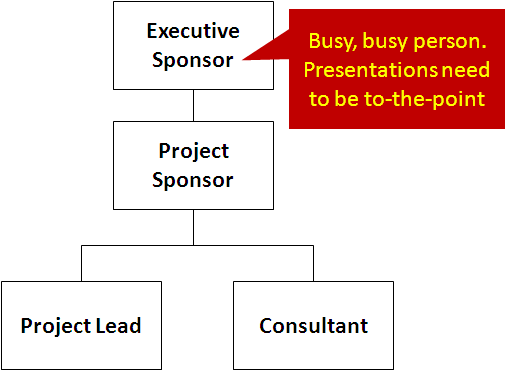Consultants spend hours making slides
It’s a common sight to see consultants pouring over their PowerPoint slides – moving pages around, adjusting the colors on graphs, mulling over wording, checking verb agreement and proof-reading. Presentations are also called “deliverables” because they are the products that we deliver to clients. It is a core part of the job, but commonly misunderstood. Reality is that consultants use PowerPoints.
Is this excessive or a waste of time?
Who knows, some might even think it is narcissistic – like someone who spends too much time in front of the mirror in the morning. After all, isn’t it the content that is important? Why bother with all the structured presentation? Couldn’t this all just be put into a written document or memo?
“Oh, you are so good making pretty presentations.”
I have heard this more than once and it drives me a little crazy. The “pretty” part of the presentation is the equivalent of choosing the garnish for a plate of pasta, or the jacket design for a book. Are clients paying $250-$500 per billable hour for presentation jockeys? Doubt it.
Why so much PowerPoint?
1. It forces brevity.
Good presentations are succinct. They may have a 60 page appendix, but the executive summary will be terse and have a point of view. Using the analogy of a tree, the presentation is the fruit. The consultant may have paid their dues with endless late nights, analysis and interviews, but the end result is a presentation. There is no glory in showing the client all the gory details. You need to really boil it down to its essence. Apply the 80/20 principle, and give the client only the good stuff. Harvard Business School essays have a limit of 400 words, which is damn tough to do.
I would have written a shorter letter, but I did not have the time – Blaise Pascal, mathematician logician, physicist

2. Executives are short on time
Often times, the executive sponsor of a project will really only commit 10-12 hours of total time for a 4 month project. The client project lead will be working with you on a day-to-day basis, but you have to remember that executives are short on time, and long on opinion. They are not going to read a 100 page MS Word doc.
3. Communication is the goal
Consultants are hired to effectively solve problems. This often means persuading people to take action. It’s not enough to put smart things on paper; there needs to be results. Often times, pieces and parts of the presentation are used by the client to “sell” the recommendation to other people – the boss, peers and others. Think head, heart, and hand.
4. Executives are visual people
Maybe it’s because they deal with lots of information (reports, emails etc) every day. Maybe they just watch too much TV like everyone else. Graphs, tables, lists, groups, diagrams all help to convey a lot of information in a concise way. Each of the shapes below can help convey meaning. They are archetype frameworks. Read posts of Nancy Duarte’s Slideology here, here, and here.
- Stage-gate process – narrowing down of options, projects, investment ideas
- Phases of a project – start, middle, and end
- Venn diagram – the overlap of 2 distinct things
- S curve – the evolution, growth, and plateau of a function
- 2 x 2 matrix – simple X vs. Y axis
5. Most people are terrible at it
This might be counter-intuitive, or just cynical, but most people are terrible at putting together compelling presentations. Just go to www.slideshare.net and randomly look up presentations. They are generally awful. Full of text, no narrative, no takeaway. They are essentially a compilation of facts, or a copy/paste from a document.
Big win for consultants. As long as people are crappy at distilling complex problems into easy-to-follow, logical recommendations that are easily communicated to executives. . . more billable hours for us consultants.
